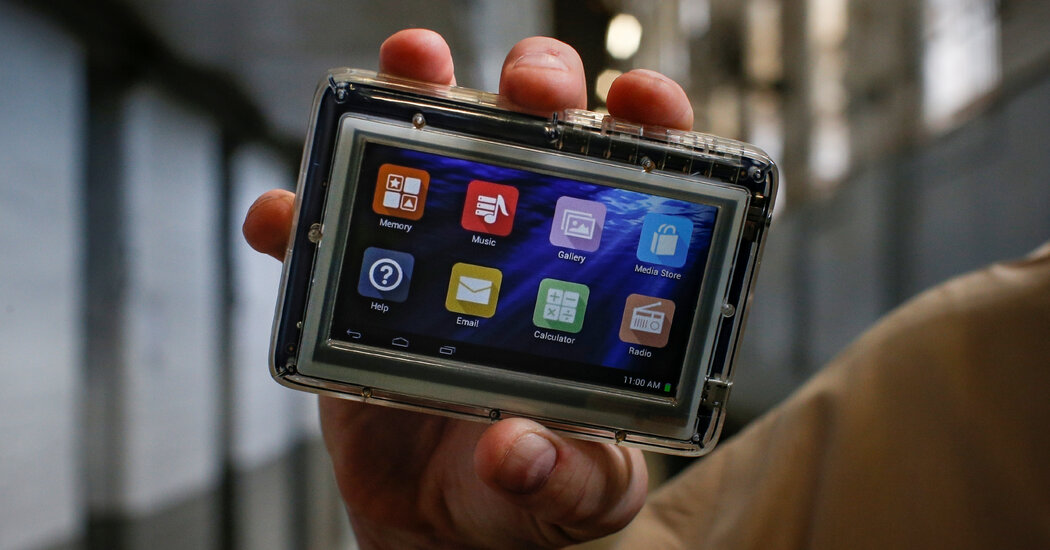Most inmates in American prisons now have a personal tablet provided by a telecommunications company, allowing them to make phone calls and play games for a fee. Although communication from behind bars has evolved over time, one thing has not changed: Someone has to pay the bill.
The Federal Communications Commission sets a maximum price that providers can charge inmates for phone calls. During the Obama and Biden administrations, it lowered the cap for prisons over time, to about 90 cents for a 15-minute call in a proposal the F.C.C. approved last year. But the agency voted Tuesday to raise that cap to roughly $1.65.
The change may seem small in dollars and cents, but the rates matter to inmates and their families, who pay the bill in most states. The F.C.C. estimated that the Biden-era proposal would have lowered bills by a total of $386 million a year. The new plan approved Tuesday is closer to the previous cap, erasing much of the savings.
The change also matters to two telecom companies that dominate the market for prison calls, and to state and local governments that operate prisons, because many of them receive significant payments from the phone companies, which critics call kickbacks.
Brendan Carr, who was appointed F.C.C. chairman by President Trump and recently suggested broadcasting companies “take action” against the late-night host Jimmy Kimmel, voted last year for the stricter caps, but has now reversed his position. In a statement, Mr. Carr said that the previous order had “negative, unintended consequences” and that the rates were dropped too low “for institutions to properly consider public safety and security interests.”
The vote was 2 to 1, with both Republican commissioners in favor.
Prison phone bills are much cheaper than they were before 2013, when the F.C.C. set its first cap on the rates. Six states, all run by Democrats, now offer free phone calls from taxpayer funds, and many more states charge prisoners well below the 2024 cap.
But in several states, like Oklahoma and Florida, the rates are close to the current regulated maximum. (The exact caps differ by facility size and whether it’s a jail or prison.) Kentucky has lowered its phone rates for prisons only twice, both times in order to comply with new F.C.C. caps.
Some states take a cut
At Northeast Reintegration Center in Ohio, Paris Siripavaket is serving a six-year sentence for aggravated vehicular homicide after her passenger died as a result of her drunk driving. In a 15-minute interview from her cell, which cost her 30 cents, she said she was “grateful” for the tablets.
When she arrived in prison four years ago, the tablets didn’t have the ability to send text messages. They now do, for a fee. The tablets can’t access the entire internet, but with dedicated apps she can also read magazines and listen to music.
Ms. Siripavaket said she heard calls were more expensive in other states, but the cost is still an issue in Ohio. “I have friends who are only able to send one message a day because that’s all they have,” she said. “They don’t have money on their phone.”
For prisons and jails, the tablets ease the logistics and potential conflicts of a central phone space. The services allow inmates to stay connected with their families, which proponents say helps reduce recidivism after they are released.
Most states also get a cut of the fees, known as site commissions.
Eric Jones, an inmate at Idaho State Correction Center serving a term for sexually abusing his child, said tablets were introduced last month. He said others spend more time on their tablets than he does, including by watching Pluto TV. While free otherwise, Pluto TV costs $15 a month on the prison tablets, of which a 25 percent cut is sent back to the state.
Chess and checkers are free, but other games and movies cost 4 cents a minute, with the state also getting 25 percent.
Sending money back to states from inmates’ phone bills has been common practice for decades. Although the money is placed in funds designated for prisoner welfare, there are few restrictions on how it is spent. The F.C.C. estimated that in 2013 the phone companies sent more than $460 million back to prisons and jails.
The latest F.C.C. proposals would ban site commissions for communication services, but not for other services like games or movies. But the future of the ban is already uncertain; a memo from Mr. Carr this month said the F.C.C. would re-evaluate the measure.
Paul Wright, who founded Prison Legal News while incarcerated, said the site commissions contribute to higher rates. “These prison phone contracts are being let out there with the idea that they’re going to generate the biggest kickback to the government,” he said.
Idaho’s tablets are provided by ViaPath, which competes with the telecom Securus in most states. The company says it can monitor calls and messages for keywords that indicate a security threat, and recently added A.I. moderation technology.
Some law enforcement officials have criticized the lower phone bill caps and removal of site commissions, which would mean less money sent to prisons and jails.
Jonathan Thompson, executive director of the National Sheriffs’ Association, stressed the need for resources to cover security. He said the passage of the Biden-era F.C.C. rule was “nothing short of an operational tax” on jails that “puts the burden on the budget of the sheriffs.”
In Arkansas, Baxter County’s detention centersuspended all calls earlier this year. Its sheriff said the Biden-era F.C.C. rules made it financially infeasible to offer them.
Tim Griffin, the Arkansas attorney general, signed onto a complaint asking the F.C.C. to reconsider its rate cap and site commission policy. He said in an interview that the previous F.C.C. “screwed up” in its calculation: “They didn’t include all the security costs that are associated with providing communications, monitoring, et cetera, which is a significant part of the cost.”
Some states pay the bill
Six states — California, Colorado, Connecticut, Massachusetts, Minnesota and New York — use taxpayer funds to cover all calls from prisons.
When Massachusetts made prison calls free, calls more than doubled.
The state spends about $1,500 per inmate per year on the calls. (It currently spends over $100,000 per year per prisoner.)
New York State’s free phone call policy for its prisons went into effect in August. Data from the state’s Department of Corrections showed a 45 percent increase in phone minutes in the first month.
Bianca Tylek, executive director of the group Worth Rises, which advocates free phone call programs, noted that telecom rates can vary widely. While Massachusetts pays Securus almost 8 cents a minute for phone calls, New York negotiated a rate of 1.5 cents a minute with the same company.
“Often we’ve found that high rates are the result of a lack of transparency across the country that leaves agencies at a disadvantage at the negotiating table,” she said.
Last week, 35 Democratic members of Congress sent a letter to Mr. Carr asking him not to roll back the Biden-era cap.
But Mr. Carr said during the vote Tuesday that the new rates would “ensure that providers keep these vital services running, safely and securely” while pointing out the rates were lower than the ones set by the F.C.C. under the Biden administration in 2021.
Anna Gomez, an F.C.C. commissioner, has cited studies showing that one-third of prisoners’ families take on debt to pay for calls or visits.
Ms. Gomez, now the only Democratic commissioner, said in a statement that the Trump administration “is more interested in granting favors to corporate interests, in this case the monopoly providers of phone and video services to incarcerated persons.”
Ben Blatt is a reporter for The Upshot specializing in data-driven journalism.
The post F.C.C. Changes Course on the Price of Prisoners’ Phone Calls appeared first on New York Times.




